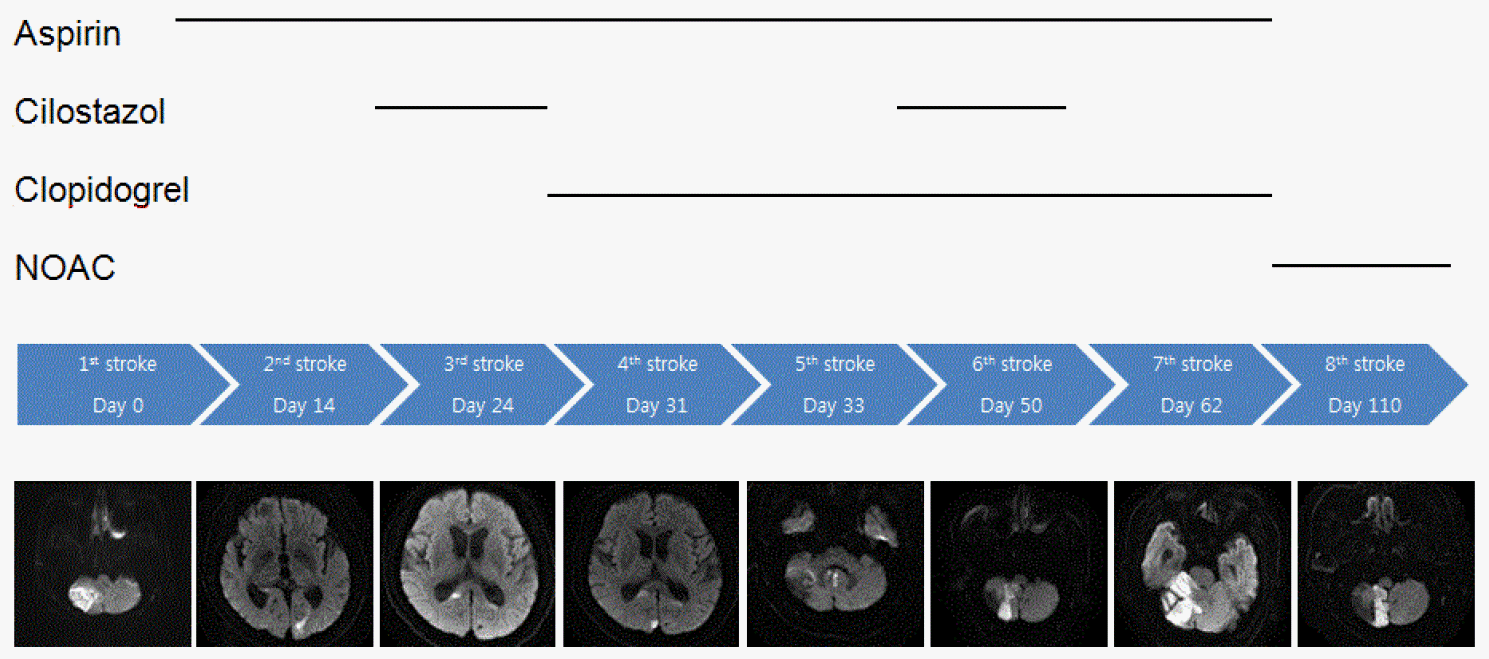비타민K비의존경구항응고제 사용 후 안정화된 재발뇌경색
A Recurrent Ischemic Stroke Stabilization after Using Non-Vitamin K Antagonist Oral Anticoagulant (NOAC)
Article information
Trans Abstract
Current stroke guidelines recommend the administration of non-vitamin-K-antagonist oral anticoagulant (NOAC) for the prevention of cardioembolic stroke induced by nonvalvular atrial fibrillation. We report a patient who suffered from recurrent posterior circulation strokes—occurring eight times in 4 months—even under adequate antiplatelet medication. Changing the medication from antiplatelet agents to NOAC stopped the stroke recurrence. We suggest that NOAC has a role in the prevention of recurrent stroke of undetermined etiology in the posterior circulation.
기존의 비타민K의존경구항응고제인 와파린을 대체하기 위해 도입된 비타민K비의존경구항응고제(Non-vitamin k antagonist oral anticoagulant, NOAC)는 비판막심방세동 환자의 뇌경색 예방에 적응증이 있다. 와파린에 비해 약물동력학적 상호작용(pharmachodynamic interaction)에서 장점이 있으며, 대부분의 연구에서 대체로 출혈합병증은 덜하며 허혈뇌졸중 발생의 예방 효과는 비열등하거나 우수한 것으로 나타나고 있다[1]. 그러나 그 외의 상황에서 뇌졸중 예방효과에 대해서는 연구가 진행 중이며 임상에서의 사용은 제한적이다.
저자들은 짧은 기간 8회에 걸쳐 반복적으로 뇌경색이 발생한 환자가 NOAC의 일종인 dabigatran 사용 후에 안정화된 예를 경험하여 보고하고자 한다.
증 례
68세 남자가 2일 전 기상 시부터 발생한 현훈과 구토를 주소로 응급실에 왔다. 과거력에서 고혈압, 당뇨병이 있던 자로 아스피린을 복용 중이었다. 당시 신경계 진찰에서 좌측 주시시 발생하는 안진 및 우측 상하지에서 실조가 관찰되었다. NIH뇌졸중척도점수 2점으로 평가되었다. 활력징후는 정상, 심전도검사에서 정상동리듬(normal sinus rhythm), 일반혈액검사에서 모두 정상이었다.
확산강조영상(diffusion weighted image, DWI)에서 우측 소뇌부위에서 출혈경색이 보였고, 혈관 영상에서는 양측 P1 분절의 협착 및 우측 척추동맥의 폐색이 보였다(Fig. 1). 우측 척추동맥의 폐색으로 인한, 큰동맥죽경화증에 의해 발생한 출혈경색으로 생각하여 이에 대하여 항혈소판제 중단 후 수액치료 유지하였다. 이후 증상이 호전을 보여 퇴원하였다.

Initial magnetic resonance imaging and magnetic resonance artery of the patient. (A, B) Diffusion-weight image and Gradient echo image shows hemorrhagic infarction in right cerebellum. (C, D) Magnetic resonance angiostudy study shows focal stenosis in right and left P1 segment and rigt vertebral artery occulusion.
퇴원 4일 후 발생한 우측 반맹으로 다시 왔으며, DWI에서 좌측 후두엽 부위, 우측 소뇌부위에서 뇌경색 추가 발병이 관찰되어 아스피린을 추가하였다. 심전도검사, 경흉부심초음파(transthoracic echocardiography), 종양표지자, 자가면역항체검사는 정상 소견, 혈소판약물반응검사(아스피린, P2Y12)에서 저항 소견은 관찰되지 않았다. 이후 1달 간 구토, 우측 상하지 운동실조, 구토, 의식 혼돈, 딸국질, 어지럼 등 증상이 추가적으로 발생하였으며, 6차례의 뇌경색 재발이 DWI에서 확인되었다(Fig. 2). 혈관영상검사는 방문 당시 소견과 차이가 없었으며, 24시간심전도모니터링, 경식도초음파, 10회에 걸쳐 심전도검사 등을 시행하였으나 우측 척추동맥 협착 이외의 원인을 발견할 수 없었다. 재발 때마다 아스피린과 cilostazol 병용요법, 아스피린과 clopidogrel 병용요법, 아스피린, clopidogrel, cilostazol 삼제 요법 등을 사용하였다(Fig. 2). 삼제 요법 사용 후 뇌경색 안정화되는 양상으로 퇴원하였으나, 3개월 후 두통, 구토로 방문하여 DWI에서 우측 소뇌부위에 뇌경색이 보였다(Fig. 2). 심전도검사 및 magnetic resonance artery에서 이전과 다른 소견은 없었다. NOAC제제인 dabigatran 110 mg을 하루 두 번 투약하였다. 이후 신경계증상의 악화 없이 안정화되어 퇴원하였으며, 퇴원 후 1년 간 재발 없이 외래경과 관찰 중에 있다.

Clinical events and magnetic resonance imaging findings (1st: right cerebellum hemorrhagic infarction; 2nd: left occipital lobe, right cerebellum infarction; 3rd: both occipital area, and right cerebellum, right side of the splenium infarction; 4th: both occipital area infarction; 5th: cerebellar vermis infarction; 6th: right cerebellum infarction; 7th: right splenium and cerebellar vermis infarction; 8th: right medial cerebellum infarction). NOAC: non-vitamin k antagonist oral anticoagulant.
고 찰
본 증례는 비열공뇌경색이 반복적으로 재발한 경우로, 각종 검사를 통해 혈액응고이상이나, 색전의 원인이 될 만한 심장질환, 암 등이 발견되지 않았다.
처음 몇 차례 재발 당시는 혈관영상에서 우측 척추동맥 폐색 소견이 보였고, 반복적으로 발생한 뇌졸중이 모두 후순환영역이었던 것을 종합해 볼 때 폐색된 부위 이후의 stump에서 발생한 혈전에 의한 동맥성색전(arteriogenic embolism)이 원인일 가능성이 높다고 판단하였다. 하지만 혈관영상에서 원위부 척추동맥은 잘 조영되고 있었고, 좌측 척추동맥에서 기저동맥을 거쳐 역전된 혈류에 의해 형성된 순환으로 생각한다면 우측 척추동맥 폐색은 반복적 재발한 뇌졸중의 직접적인 원인이 아닐 가능성도 고려하였다.
또 최근에 우리 환자처럼 후 순환영역에만 수차례 재발하는 뇌경색을 보인 환자에서 이상 뼈돌기(anomalous bony process)에 의한 척추기저동맥의 압박이 원인이었던 증례보고도 있었다[2]. 이를 참고하여 검토하였으나 우측 후두부나 경부에 뼈구조의 이상은 없었다.
발병기전이 명확하지 않으나 동맥동맥색전(artery to artery embolism) 가능성이 높다고 판단되어 3개월간 다양한 조합의 항혈소판제를 투약하며 경과 관찰하였으나 안정화 되지 않고 여덟 번이나 발생하여 다른 대안이 필요한 상태였다.
재발 초기부터 와파린을 고려하였으나 첫 뇌경색 발생시 출혈변환이 동반되었으며, 투약하던 약물이 많아 약물상호작용의 우려가 많았던 점과 환자의 형제가 뇌출혈로 사망한 가족력이 있어 와파린의 사용에 거부감이 많은 상황이었다.
많은 연구를 통해 작용 부위가 단순한 NOAC제가 약물동역학적 이점과 뇌출혈 등 주요 출혈 합병증은 더 적었던 점을[1] 고려하여 트롬빈저해제인 dabigatran을 투약하고 이후로는 1년 간 뇌경색의 재발이나 출혈 합병증 없이 안정화되었다.
일부 연구에 의하면 동맥성색전증에서도 항응고제가 유용할 가능성이 제기되고 있다. 관상동맥질환에서 심근경색의 예방에 있어 와파린과 아스피린이 동등한 효과를 보여준 연구가 있으며[3], NOAC이 급성관상동맥증후군에서 동맥성 혈전형성을 억제한 결과도 있다[4]. 대동맥죽경화증에 의해 기인한 뇌경색에서 항응고제가 뇌경색의 재발을 감소시킨 보고도 있으며[5] 또한 ESPRIT 연구 등을 보면 항응고제가 항혈소판제보다 우월하다고는 할 수 없지만 어느 정도의 동맥계의 혈전생성을 감소시키는 효과가 있다는 것은 명확해 보인다[6].
이런 이론적 근거로 해서 원인불명의 색전경색증(Embolic Stroke Unknown Source, ESUS)에서 경구 항응고제나 NOAC을 적극적으로 이용해야 한다는 주장도 있다[7]. 그러나 이런 주장은 추후 대규모 연구를 통해 입증되어야 하며 항응고제의 항혈전색전효과 보다는 출혈 합병증으로 인한 안정성이 더 문제이므로 아직까지는 일반적으로 받아 들여지기에는 무리가 있다.
다만 본 증례처럼 항혈소판제 사용에도 불구하고 짧은 기간에 재발하며, 출혈합병증 위험성으로 와파린 사용이 어려운 환자의 경우에는 심방세동이 확인되지 않은 경우라도, NOAC제제를 대안으로 고려해 볼 수 있겠다.